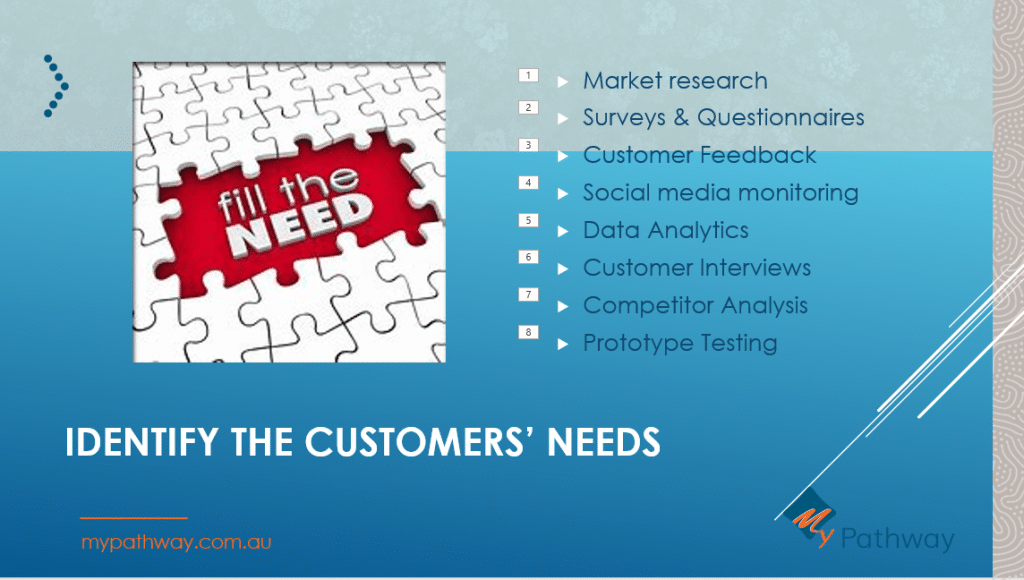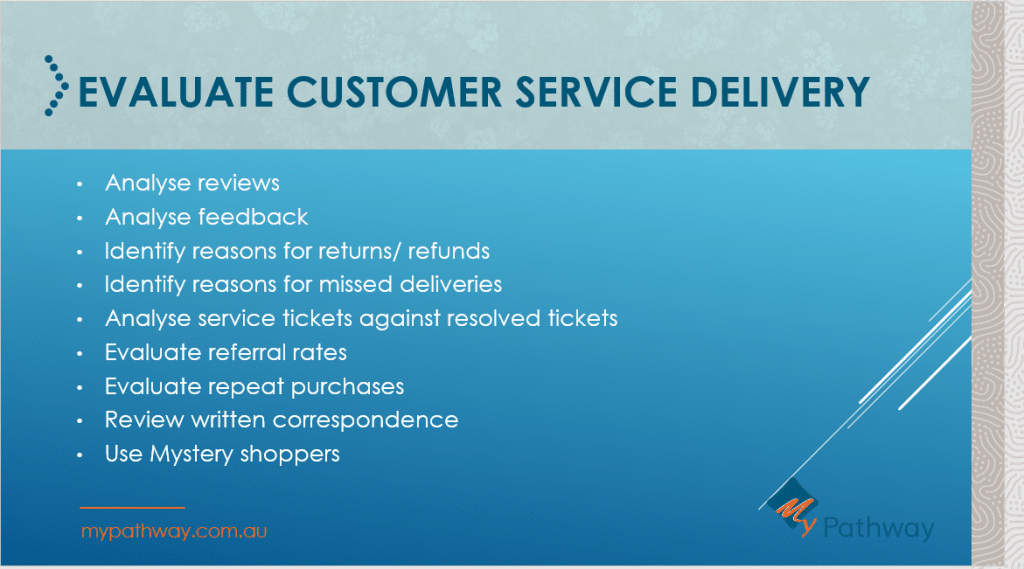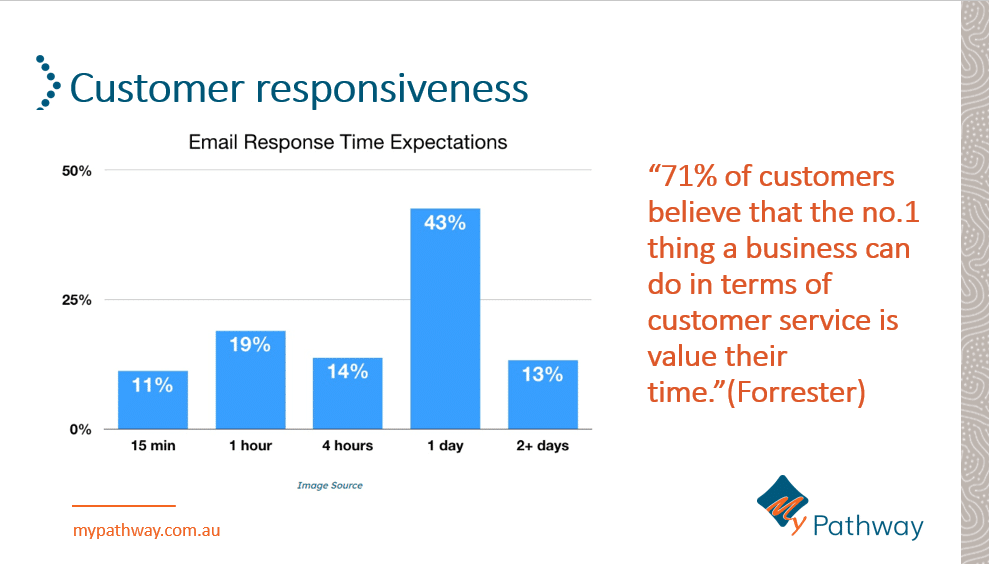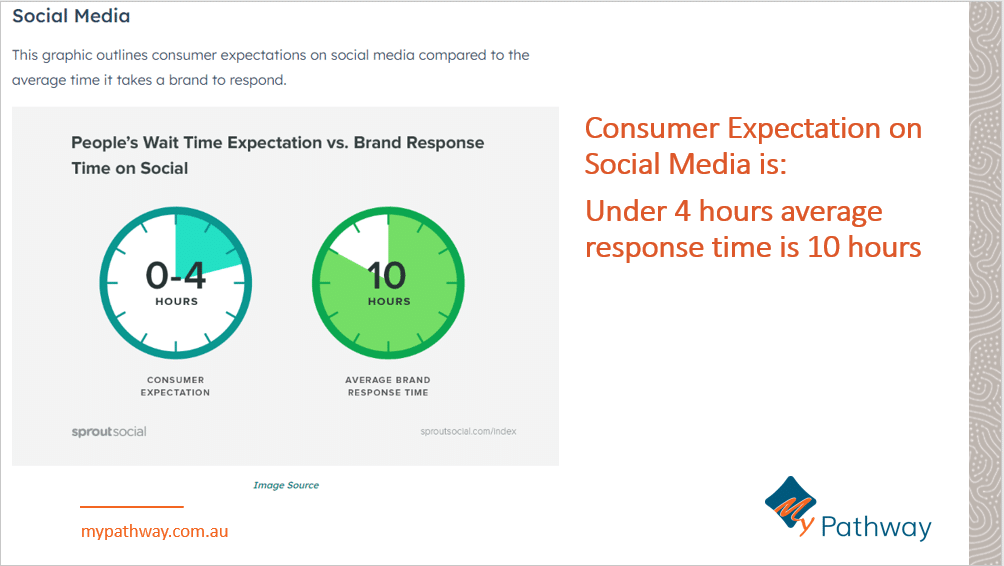Deliver and monitor a service to customers
About the Unit
Customer service is vital to the success of every business. Our role is to solve the customers problems. To do this, we need to determine their needs, satisfy these needs and make them feel special so they return and become loyal customers.
This unit explores how to give the best customer service, your legal requirements, your policies and procedures and enables you to put it into practice.
Start with the Study guide BSBOPS304.
What could the nail have anything to do with customer service?
Learning Outcomes
BSBOPS304 Deliver and monitor a service to customers
- Identify Customer needs
- Deliver customer service
- Evaluate Customer service delivery

Click on tabs for Learning Content.
It’s all about the Customer- without them, there is no “us” in business.
Customer satisfaction is a key contributing factor to business success.
Identifying your customers’ needs, understanding your target market, what their pain points are and how you can improve will increase customer satisfaction.
Effectively communicating with your customers will result in you delivering the standards they expect.
Designing and implementing policies and procedures will ensure consistent customer service and protect you from any possible loss of reputation.
Regular and ongoing evaluation of customer service delivery, customer feedback, refunds and returns allows improvements to be made and shows your customers you do listen.
We want happy, loyal customers who will return and recommend us to their friends and family. We can achieve this by listening to them. Keep doing what they like and change what they don’t. Valid and reliable customer feedback is essential to the success of your business.
Identify your customers’ needs so you can satisfy them. There are many methods you can use to determine this:
- Understand your target audience- behavioural, demographic, psychographic- your market segment- what do they want?
- Surveys, questionnaires, customer interviews-find out preferences, pain points, what improvements they would like to see.
- Customer feedback- seek feedback through numerous channels-email, social media- how can you improve? Be proactive.
- Social media monitoring- what are they saying about your product and your competitors, look for trends, common complaints and info about your competitors.
- Data Analytics- use this to analyse customer behaviour on your website or app-identify what products are popular and what can be improved.
- Prototype testing-produce minimum viable products and test them with a select group of customers, gather feedback on usability, features and overall satisfaction.

➡Review Knowledge Question 1, 2, 3
Legislation, rules and regulations are in place to protect the customer from unethical practices.
Australian Consumer law covers:
- Product safety
- Lay-by agreements
- Unsolicited Consumer agreements
- Product labelling
- Price monitoring
- Unfair market practices
- Consumer guarantees
As a business owner, you need to understand Consumer guarantees to ensure happy, loyal customers and repeat business.
Other laws and regulations that may refer to your business
Consumer Guarantees under Australian Consumer Law
What are your responsibilities if you provide a service?
Policies and Procedures
In order to remain compliant and not risk breaking any laws, you will need to put some systems and processes in place. These are known as “policies and procedures”.
You might have a “Refund Policy” that you have created based on Australian Consumer Law.
The procedure is the step by step process you expect your staff to follow to ensure they do not break the law and put your business at risk of litigation.
Learn more about how to write a procedure from the video below:
➡Review Knowledge Question 5
Top tips on how to give good customer service
Good customer service will help you thrive. Understanding what good customer service is and how to provide it will help you achieve your goals.
- Be friendly, courteous and amicable
- Respond promptly
- Know your product or service inside and out
- Listen to your customers
- Thank your customers for their custom
- Get to know your customers, build a rapport with them
- Ask for feedback
- Follow up after the sale
This video shows you how NOT to listen.
Handling Customer Complaints
Remember- any feedback positive or negative is a good thing! If you have an unhappy customer whose needs you have not met, they may complain. It is important to:
- Listen to them (stick to the issues and don’t take it personally)
- Ask questions to clarify that you understand what the issue is
- Fix the problem fast or find a solution.
- Follow up to make sure they are happy with the resolution.
Put yourself “in the customer’s shoes”. Empathy and understanding are key to resolving issues. Make the customer feel that you really understand why they are unhappy, clarify your understanding of the issues and stay calm throughout.
This video is a good example of how to deal with a customer complaint.
➡Review Knowledge Question 4
Customer Feedback
Feedback from customers is an invaluable asset to any business. There are many different feedback channels available to us both digital and non-digital. The links below discuss what Customer Feedback is, why we should gather it and what to do with the data once it is collected.
Customer Responsiveness
Time is precious to us all, and prompt service makes us feel appreciated.
Remember the last time you were put on hold for over 5 minutes? Did you feel like the company cared about you and your time?
How did you feel when you were put on hold, but the message told you, you were next in line? That brief acknowledgement helps you trust that business a little more.
How about when you were put on hold, and the recorded message asked you to leave your number and they will call you back? Wow, a proactive company that understands my busy life and offers a solution!
Ideally, a person answering the phone within three rings would be perfect, however, not always achievable.
How quickly and efficiently a business answers the phone and responds to questions or delivers their products will affect the customers’ perception of how reliable and trustworthy the business is.
Setting standards, training staff in procedures, putting processes in place and monitoring these will allow you to provide excellent customer service above and beyond expectations and beat your competitors.
Customer responsiveness refers to how quickly and accurately your business is able to support customer requests. It is a measure of the speed it takes to respond to a customer enquiry and how quickly their request is completed.
A customer responsive culture puts customer’s needs first and promotes a solutions focused mentality.
Average customer response times
Hubspot states that the average customer response times in March 2023 are:
- Email- 12 hours and 10 minutes across industries
- Call centre- 46 seconds
- Live chat – 5 minutes and 57 secs
- Social media responses – 1-2 hours.
Can your business do better? Think about what procedures or KPI’s you could implement to encourage a culture that puts customers expectations first.
The images below indicate customer expectations on response times for Social media versus emails.
These figures indicate an opportunity for your business to do better and improve customer service.
Evaluate your customer satisfaction by analysing the information you have collected.
Reliability of information is when

Portfolio Evidence Task 1-
Submit 5 Customer service policies and procedures for the following:
- Customer Complaint Handling policy and procedure
- Refund policy and procedure
- Communication policy for email or social media.
- Anti-discrimination policy and procedure (special needs and disability)
- Customer Satisfaction survey.
Refer to the guideline template below to guide you through writing these.
Portfolio Evidence Task 2:
Ask 3 customers to complete your customer service survey. Include completed surveys in your portfolio.
Your customer service survey needs to identify any areas of improvement for your product or service.
You may also choose to include google analytics or reviews as evidence of customer feedback.
Please include your responses back to the customers.
Portfolio Evidence Task 3.
Provide a summary/ email to your assessor outlining the feedback you received, the opportunities you identified and the actions you intend to take to improve your business and maintain quality service to your customers.
Show us how you do it.
Assessment 3 is all about putting what you have learned into practice.
Task 1 – is examples of how you established what your customers needs were. Give examples for 3 separate customers.
Task 2a – From the needs you established in Task 1- How did you deliver customer service to meet these needs for these 3 customers.
Task 2b,c,d,e- respond to questions
Task 3- Create and email to a business partner addressing the following:
- summarise feedback recieved
- discuss opportunities you have identified based on this feedback
- offer recommendations, actions and improvements to improve the quality of the customer service experience.
The 3 steps to customer service
Do you know them? Click on the boxes below
Step 1: Listen and Smile
Smile and listen- the smile needs to be in your voice, in your emails, in all of your messaging.
Make your customers feel welcome.
Step 2: Ask and empathise
Ask questions to clarify the customers’ needs.
Know your products well so you can help solve their problems.
Step 3 Follow up and Feedback
Thank your customers, ask them for feedback and follow up after the purchase to make sure they are happy.
News feed





